Albania travel tips: Things I wish I’d known before visiting Albania
My husband, Albert, and I decided to go to Albania rather randomly and without any preparation. He had a month’s vacation, and we planned to attend a friend’s wedding in Lefkada, Greece. We love road trips, so we decided to drive down to Greece and then spent the rest of the vacation working our way back up. Since neither of us had been to Albania, it seemed the obvious route, and we spent about a week visiting historical sites.
Disclosure: This article contains affiliate links. If you make a purchase through one of these links, I will receive a small percentage. It will not affect your price.
Albania used to be a hermetically-sealed dictatorship whose leader, Enver Hoxha, was a Stalinist and broke with the Soviet Union after Stalin’s death. I knew, of course, that things have changed since the break-up of the Soviet Union and that Albania has applied to join the EU, but it still felt exciting to go there.
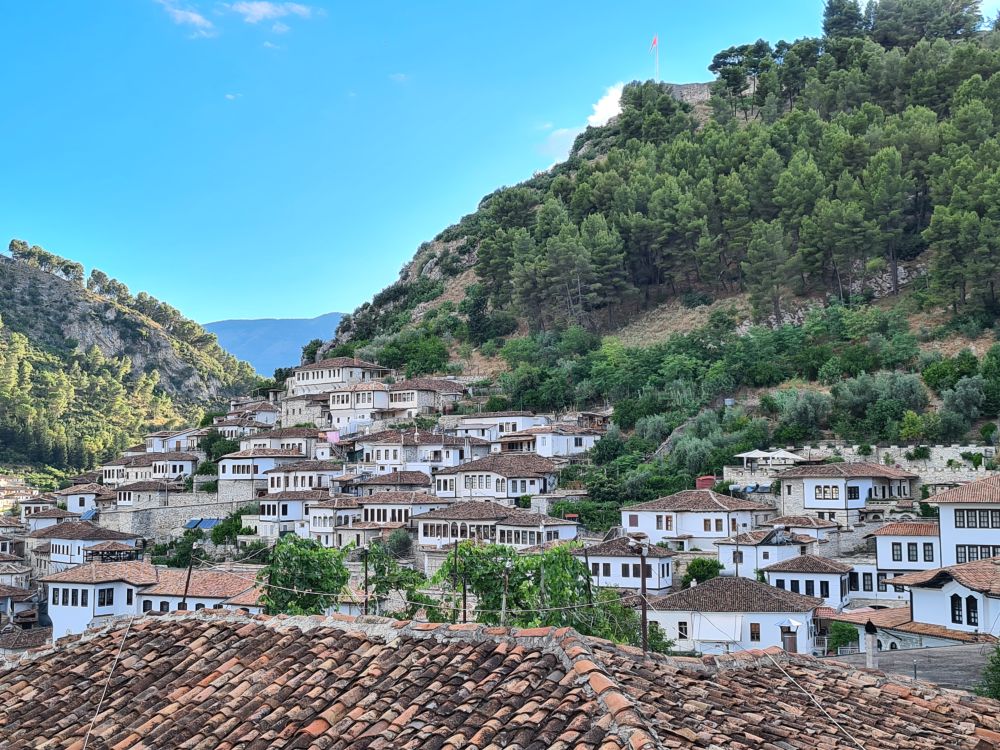
With our complete lack of research and preparation, there were a number of things about Albania that took us by surprise: things I wish I’d known before traveling in Albania. Here are my observations and the travel tips for Albania that derive from them.
A disclaimer: I am not an expert at all about Albania. I’m just someone who recently traveled there and, from my Dutch/American point of view, made some observations.
Papers you need to enter Albania
You’ll need a passport, of course, and you should check visa requirements for the country of your passport. You might also need an International Driver’s License, depending on where you’re from. In our case, as EU citizens, we could enter Albania freely.
But there are some other documents you’ll need if you’re driving in Albania. If you’re renting a car, make sure to ask the rental agency about these:
Tip #1: Bring your car registration form, i.e. proof of ownership.
If you’re driving into or out of the country – and this applies to North Macedonia and other countries too – you need to be able to show your registration. We had to show it on entering most countries, and for many of them also on exiting.
Tip #2: Bring your car insurance papers.
They may ask at the border for your insurance papers for the car as well. Ours in the Netherlands is called a green card, though it’s a full sheet of paper. We didn’t have it with us – Albert’s fault, not mine! – when we first entered North Macedonia, but fortunately they took pity on us at the border and let us through anyway. We managed to get our insurance company to email it to us so we’d have it with us next time. Upon both leaving and re-entering Albania, border police asked for insurance papers as well as passports and car registration.

Tip #3: Have a back-up copy of your documents.
At my insistence, Albert had forwarded the email to me with the insurance document. And a good thing too: the next time we went into North Macedonia, the border agent took Albert’s phone to look at the document and, whether intentionally or not, managed to erase it. It wasn’t even in his email trash file. Fortunately, I had my copy so it wasn’t a problem.
Language in Albania
Tip #4: Make Google Translate or a similar program your friend.
In most countries where I’ve traveled – about 70 at last count – I could usually be pretty sure to find someone who spoke English. At least at hotel reception desks, for example, and tourist-related sites, someone would have some modicum of English. Not in Albania. Occasionally we found someone, usually a young person, who could speak a very little: enough to get an answer to a simple question. But most of the time, we couldn’t find anyone who spoke any English.
Google Translate helped us out a lot. Have it or any other similar app ready on your phone’s homepage so you can access it quickly.
Driving in Albania
Tip #5: Get a proper old-fashioned paper road map of Albania.
Google maps and your car’s navigation system – or at least our car’s navigation system – don’t show whether roads are paved or gravel. They also don’t indicate how well-paved they are: whether they’re nice and smooth and well-graded or full of potholes and patches.
We tried to drive between Gjirokaster and Berat, two towns that together make one UNESCO site. Both our GPS and Google maps chose the same route that was clearly the shortest and most direct. It was a numbered route, not some obscure local road, so off we went.
It turned out to be a nightmare route. I’m not exaggerating when I say that in all my travel in East Africa, I only once saw a road worse than this one. It was large gravel and rocks and had never been graded, as far as I could see. As we moved along it, climbing a mountain, it got worse and worse. For example, in some spots one side of the road had partly collapsed into the valley below. On steep slopes, the gravel prevented us from getting good traction. And we had to pick our route carefully to avoid scraping the bottom of the car.
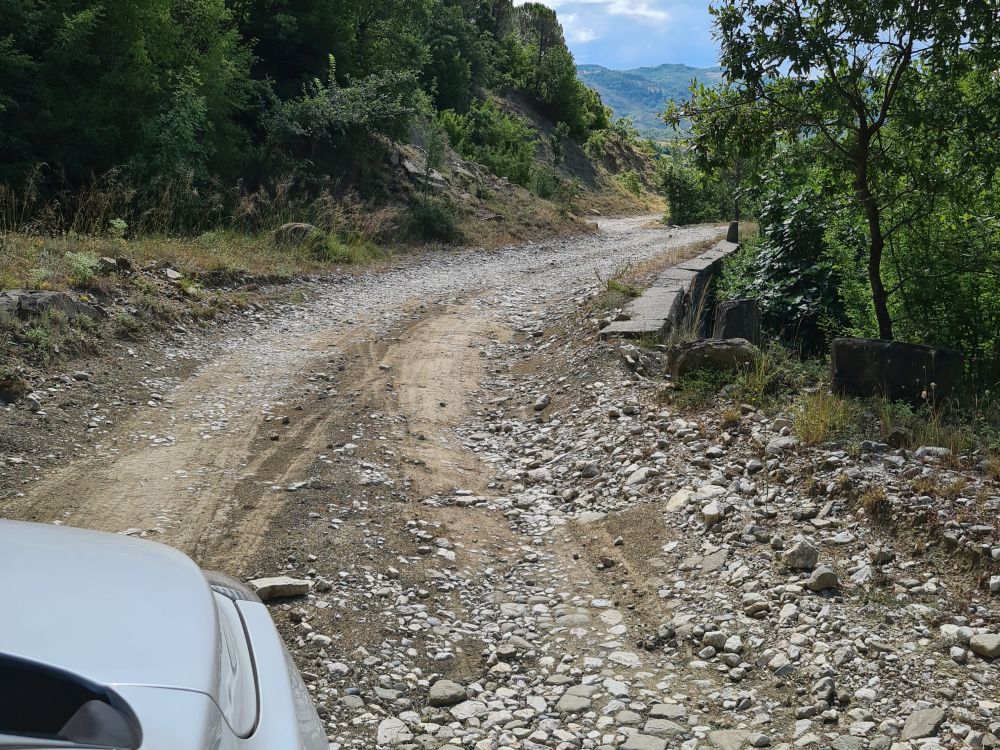
At one point a stone bridge over a ravine had crumbled on one side, leaving a narrowed surface with only one side wall. Perhaps a motorcycle could have crossed but there was no way we were going to risk the car and our own lives crossing this bridge. We clearly weren’t the first ones to come to this conclusion because we noticed another track nearby. It turned out that enough other vehicles had simply gone around the ravine to create a new road that bypassed the bridge.
Eventually, as the road got rougher, steeper and narrower, we called it quits and managed to turn around and go back. It turned out that there was a perfectly good paved road we could use; it was a far longer distance but nevertheless much safer.
So that’s why you should buy a proper road map of Albania. Don’t settle for a limited tourist map from a guidebook, though. Get the big fold-out kind. Those usually give an indication of which roads are paved and which aren’t, and you’ll save lots of time not taking wrong turns.
Tip #6: Get the full collision damage waiver.
While I’m talking about bad roads, it’s worth adding this tip. If you rent a car in Albania, go for the full collision damage waiver. You’re likely to scrape the bottom of the car or scratch the paint on the bushes along the side of the road or a hundred other possibilities.
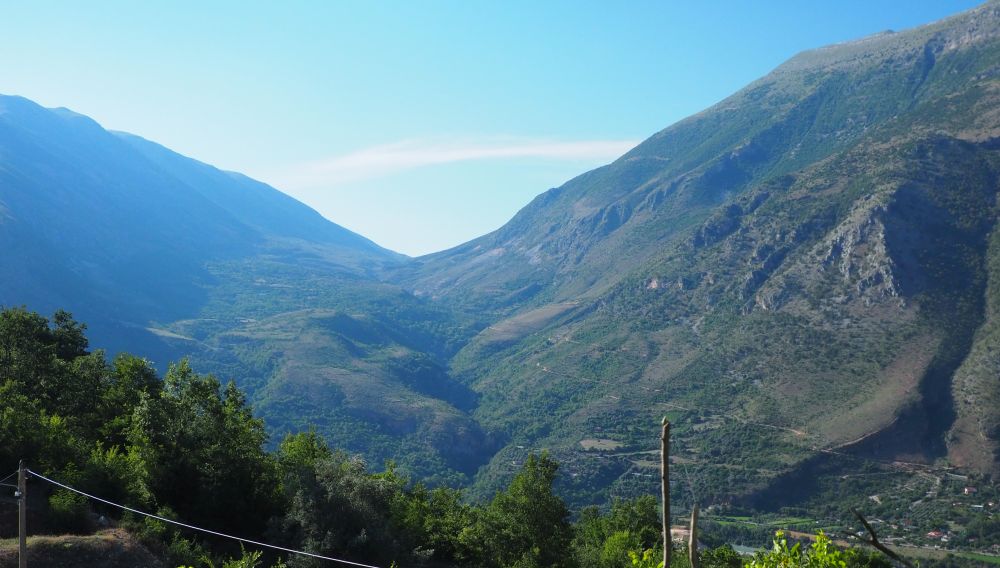
Getting around in Albania
Tip #7: Don’t trust tourist maps.
Since we’re already on the topic of maps, don’t trust tourist maps either. We tried to use them a couple of times and they just don’t match the reality on the ground. I don’t know how many times we took wrong turns in Albania! In Berat, we spotted signs twice that claimed to show where all of the historic houses of interest were. Gamely we took a picture of the first one, wandered around not finding any of the houses, and eventually discovered another map on another street. At first glance, it was the same image. But after studying it, we realized that it showed both the streets and houses in different places than where they were on the first map!
Tip #8: Don’t follow signs to historical sites.
Take my word for it: there is only that one single sign! We kept falling for it: “Oh look, there’s a 12th-century monastery down that road! Let’s go see it!” But we only rarely found it.
You will not receive any other hints after that first sign as to which turns to take to actually get you to that location, nor how far it might be. And since you’re unlikely to find anyone who speaks English, you can’t stop and ask for directions. One time I decided to check with Google maps, after we’d gone a kilometer or two down a side road, come to an intersection and didn’t know what to do. It turned out that the signpost had been indicating a monastery that was 55 kilometers away!
For local directions within a town or city, we mostly relied on Google Maps, though, again, sometimes we didn’t get where we wanted to go because Google Maps doesn’t see whether a road is or isn’t passable. A few times it tried to lead us down roads that were actually stairways! Generally, though, Google Maps worked better than our car’s navigation.
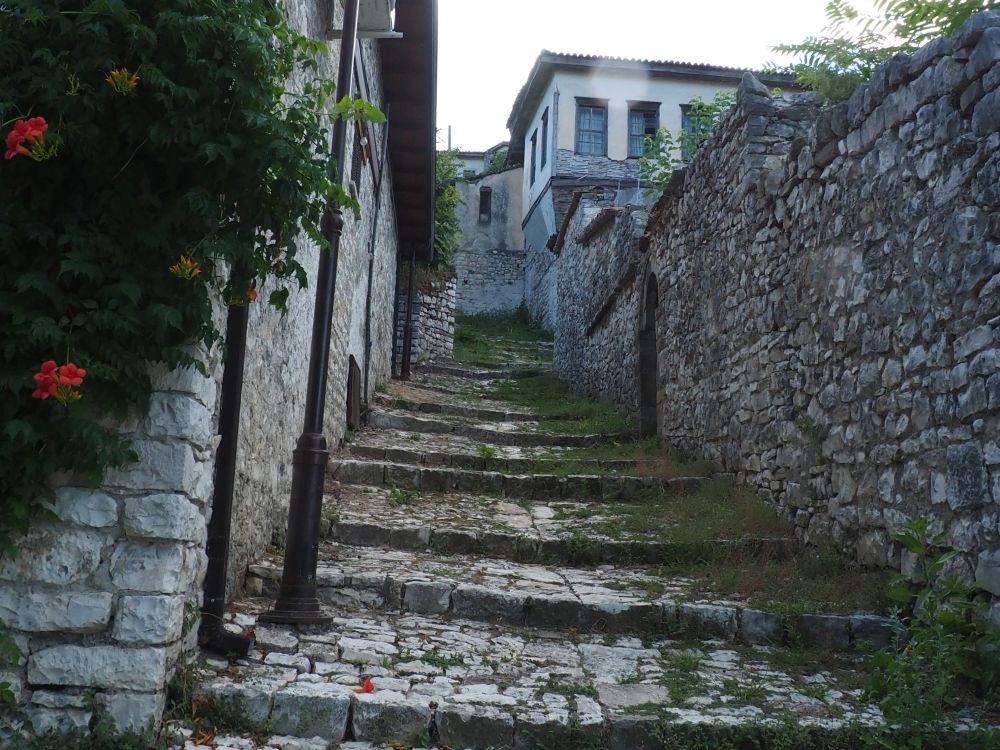
Travel tips about driving in Albania
Tip #9: Follow the locals’ lead.
Often, even on the better roads, signs show speed limits that are surprisingly low. We wondered why, at first, but it became clear that even what we might consider highways are used by locals in ways we aren’t used to. We had to stop, for example, for a herd of sheep to cross the road. Once it was a herd of cows. We had to slow for a horse and cart, and also for people walking or riding donkeys.
At the same time, when the speed limit goes down to a very low 40 kph around a bend, there’s unlikely to be any corrective sign after the curve marking where you can speed up again. Locals seem to assume that they have to stay at that low limit for a few hundred meters, and then they speed up.
The standard speed limits in Albania are 40 kph in towns, 80 kph outside towns, 90 on expressways, and 110 on freeways. It’s not clear to me what the difference is between an expressway and a freeway, but often you can actually go the speed limit on those. In and outside of towns, though, it’s generally better to go slower than the standard speed limit, even if there’s no sign requiring a lower speed. You never know when you’ll suddenly have to brake for a herd of goats or a tortoise crossing the road – yes, that happened to us – or for a sudden gaping pothole.
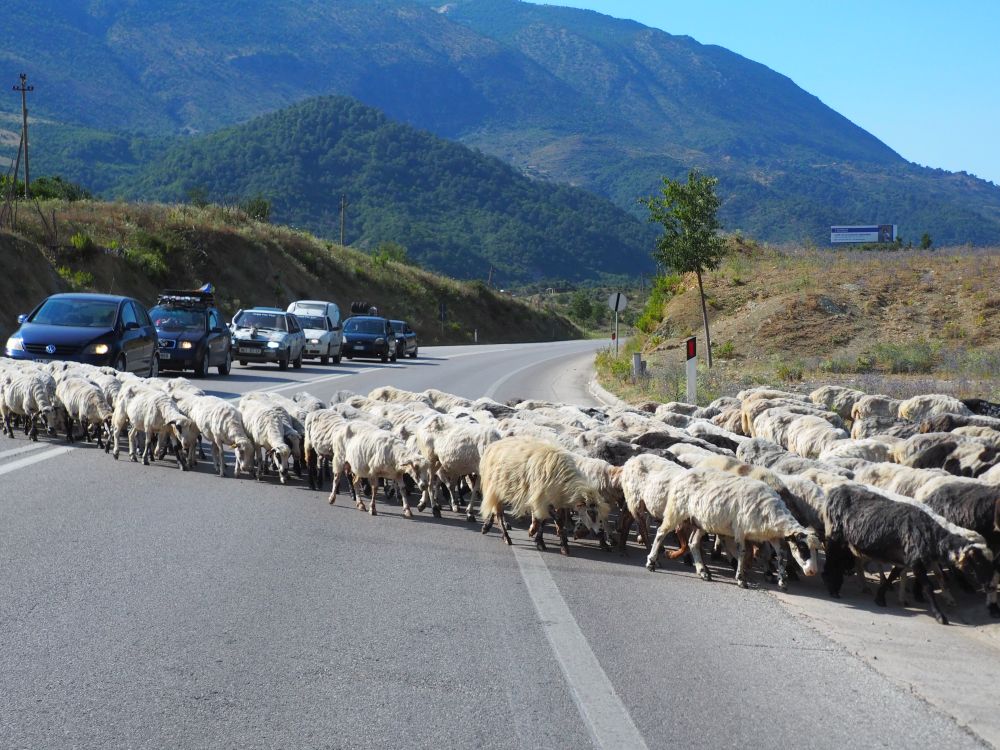
What seemed to work for us was to follow the locals’ lead. If they slow down, you slow down. If they speed up, you’re probably okay to speed up.
Tip #10: Slow down for blinking headlights.
If people blink their lights at you coming the opposite direction, they may be warning you about traffic stops. At random places, policemen stand along the roads and stop cars. They don’t stop everyone, and we never got stopped, but I have no idea how they decide who to stop. Slow down, in any case.
Tip #11: Help people pass you.
While I found Albanian drivers to be quite cautious and careful for the most part, there’s one thing they do that seemed quite dangerous. If someone honks their horn lightly behind you, they’re probably planning to pass you. And they’ll do so whether or not there’s actually room to pass.
Maintain your speed, and pull over as best you can into the shoulder to help them pass. They’ll sometimes pass even with someone coming in the other direction, so they need to move fast.
Tip #12: Be very cautious in roundabouts and intersections!
In roundabouts, the rule in Albania is that if you are entering the roundabout, the cars already in the roundabout have to let you in, i.e. you have priority. However, we almost never saw that happen. In fact, what we saw was what we’re used to in the Netherlands: cars in the roundabout have the right of way, and cars entering waited for an opening to move into the circle.
Likewise, the rule is that cars approaching an intersection from your right, if there are no signs saying otherwise, have the right of way, just like in the Netherlands. But again, the practice seemed different: the cars on the bigger roads seem to get priority – or perhaps I should say they take it – much like in the US. There are very few stop signs anywhere, and they generally seem to be ignored.
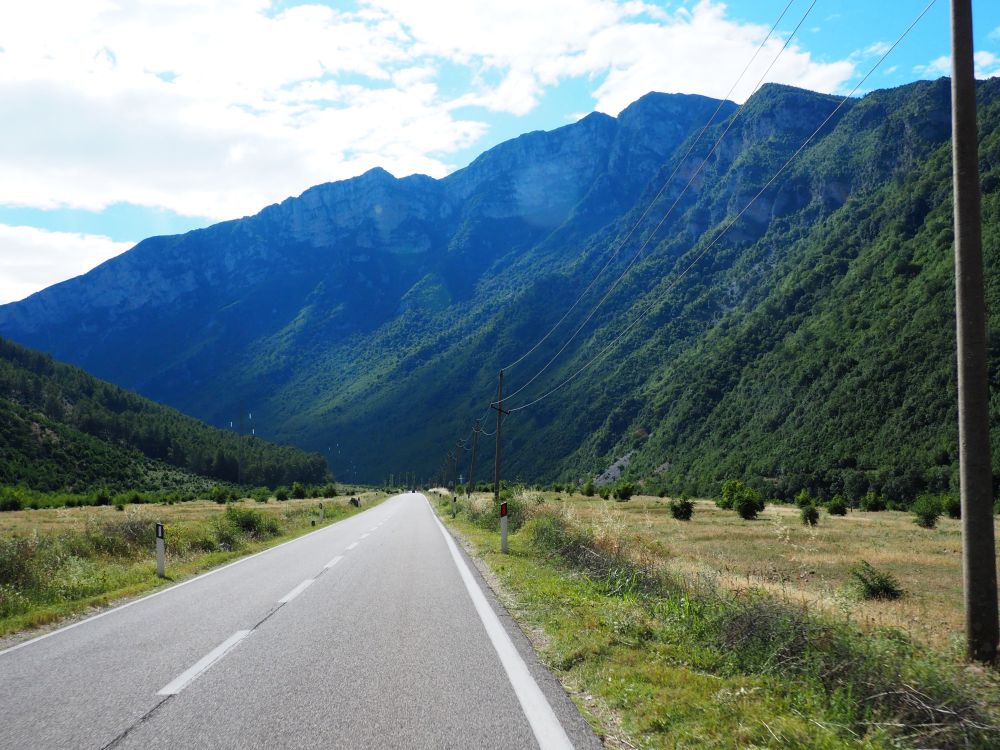
Money in Albania
Tip #13: Take Albanian leks out of an ATM when you arrive.
Albania is a cash economy. Even hotels want to be paid in cash. This may not apply to the top-end international chain hotels, but the mid-range, locally-owned 3-4-star hotels we stayed in all wanted cash. Gas stations,too, want cash.
Nevertheless, travel in Albania is very reasonably priced. It was summer, presumably the high season, and we mostly paid the equivalent of 35-40 euros per night for decent hotels with private bathrooms, air conditioning, free wifi, and breakfast. (I should add that I booked each hotel just the day before or the same day via Booking.com. Since I use it so much, I’ve qualified for their “genius discount” which often got me 10-15% off my price.) These weren’t coastal towns, so perhaps it would be higher for a beach holiday. Gas, on the other hand, was just as pricey as at home.
Tip #14: Don’t be shy to ask how much food costs.
Food is distinctly less expensive than at home in the Netherlands too. On the other hand, you’ll sometimes get charged for things that might surprise you. At one hotel, for example, we asked the waiter if Albert’s steak came with fries. She told us yes, and also salad and tzatziki. Then when the bill arrived, it turned out that we were being charged for each of these items. It was very cheap, but still, we would have liked to know ahead of time that these things cost extra.

Other Albania travel tips
Tip #15: If you don’t get offered coffee or tea over breakfast, just ask.
At breakfast, despite the fact that breakfast was included, we sometimes had trouble getting a cup of tea. One hotel served cold tea: not iced tea, but cold tea in a teacup. At another, the waiter gave us each a glass of whole milk and a glass of juice with breakfast, but did not provide tea or coffee. We had to pay for them for separately,
We learned to specify that we wanted hot black tea, and that we didn’t want milk.
When we finally found an employee who spoke good English and asked her about the lack of hot tea or coffee at breakfast, she looked a bit puzzled. “In Albania coffee is for later in the day. We don’t drink it at breakfast.”
Tip #16: Bring hand soap along.
For some reason, many of the hotels we stayed in didn’t offer hand soap in the en-suite bathroom. There was shampoo, but no soap.
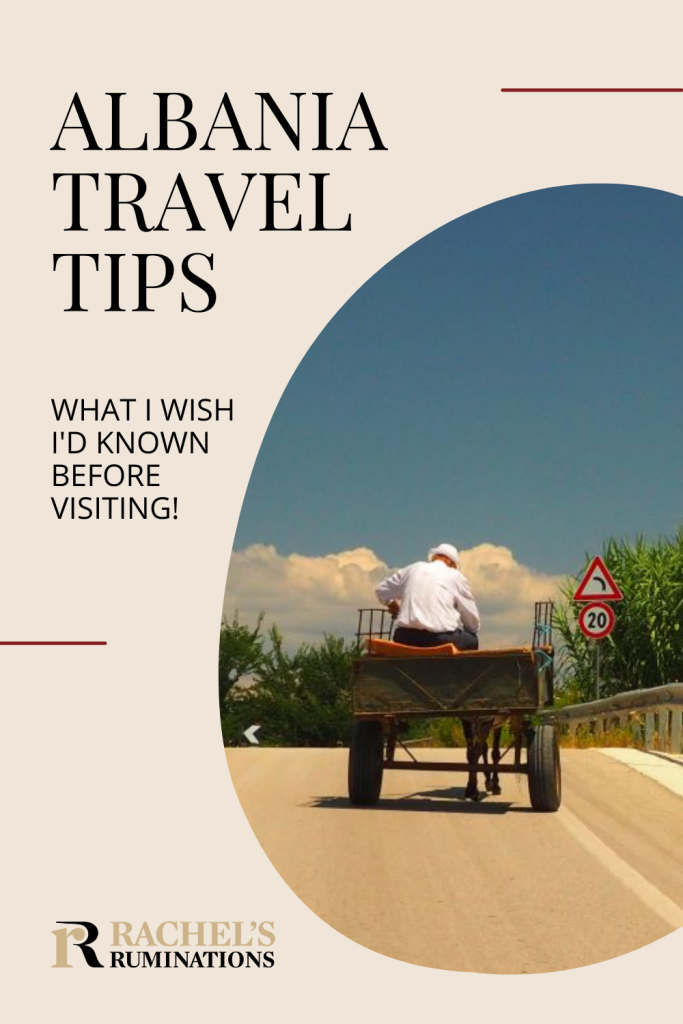
Tip #17: Go to Albania!
Despite all these observations, please don’t let me discourage you from traveling in Albania! It is an absolutely gorgeous country, especially in the mountainous areas, as you can see from some of the photos I’ve included in this article. Consider Theth National Park, for example, in the “Albanian Alps.” We didn’t visit the coast at all – we’re not beach enthusiasts – so I can’t be sure how it is along the coast. We really enjoyed visiting the historical sites we love without contending with hordes of tourists, like you’d see in, for example, Dubrovnik or Rome.
This page on Bookmundi might help you choose a time of year to travel to Albania. If you’re interested in the beaches, choose late spring or early fall rather than mid-summer to avoid crowds. Bookmundi, by the way, lists some good-sounding small-group or private tours in Albania.
If you’ve been there and you have more Albania travel tips that should be on this list, please add them below in the comments!
My travel recommendations
Planning travel
- Skyscanner is where I always start my flight searches.
- Booking.com is the company I use most for finding accommodations. If you prefer, Expedia offers more or less the same.
- Discover Cars offers an easy way to compare prices from all of the major car-rental companies in one place.
- Use Viator or GetYourGuide to find walking tours, day tours, airport pickups, city cards, tickets and whatever else you need at your destination.
- Bookmundi is great when you’re looking for a longer tour of a few days to a few weeks, private or with a group, pretty much anywhere in the world. Lots of different tour companies list their tours here, so you can comparison shop.
- GetTransfer is the place to book your airport-to-hotel transfers (and vice-versa). It’s so reassuring to have this all set up and paid for ahead of time, rather than having to make decisions after a long, tiring flight!
- Buy a GoCity Pass when you’re planning to do a lot of sightseeing on a city trip. It can save you a lot on admissions to museums and other attractions in big cities like New York and Amsterdam.
- Ferryhopper is a convenient way to book ferries ahead of time. They cover ferry bookings in 33 different countries at last count.
Other travel-related items
- It’s really awkward to have to rely on WIFI when you travel overseas. I’ve tried several e-sim cards, and GigSky’s e-sim was the one that was easiest to activate and use. You buy it through their app and activate it when you need it. Use the code RACHEL10 to get a 10% discount!
- Another option I just recently tried for the first time is a portable wifi modem by WifiCandy. It supports up to 8 devices and you just carry it along in your pocket or bag! If you’re traveling with a family or group, it might end up cheaper to use than an e-sim. Use the code RACHELSRUMINATIONS for a 10% discount.
- I’m a fan of SCOTTeVEST’s jackets and vests because when I wear one, I don’t have to carry a handbag. I feel like all my stuff is safer when I travel because it’s in inside pockets close to my body.
- I use ExpressVPN on my phone and laptop when I travel. It keeps me safe from hackers when I use public or hotel wifi.



Rachel: My wife and I traveled through Albania in May 2024. We also visited neighboring countries including North Macedonia, Kosovo, Montenegro, and Bosnia & Herzegovina. Like you, we started in Greece and entered Albania from Meteora and Ioannina before staying in Gjirokastër.
We toured the country for 11 days exiting through Shkoder and into Montenegro. We managed to avoid some of your challenges by having an Albanian-speaking tour guide who handled the border crossings and other times when we needed a translator.
I can provide more details about the trip, our guide, and the tour company on our blog post https://cosguide4travel.com/albania-is-worth-visiting/.